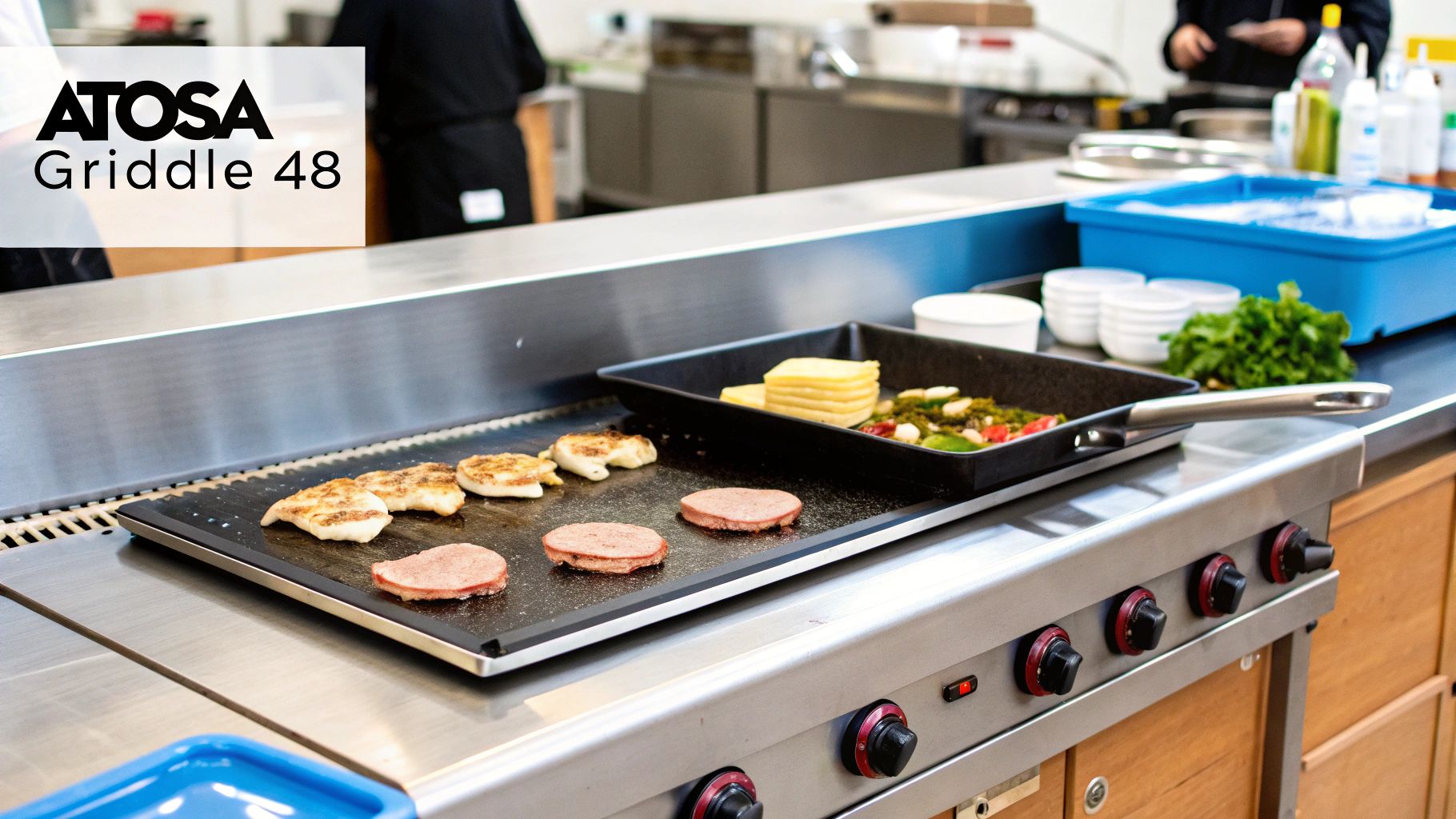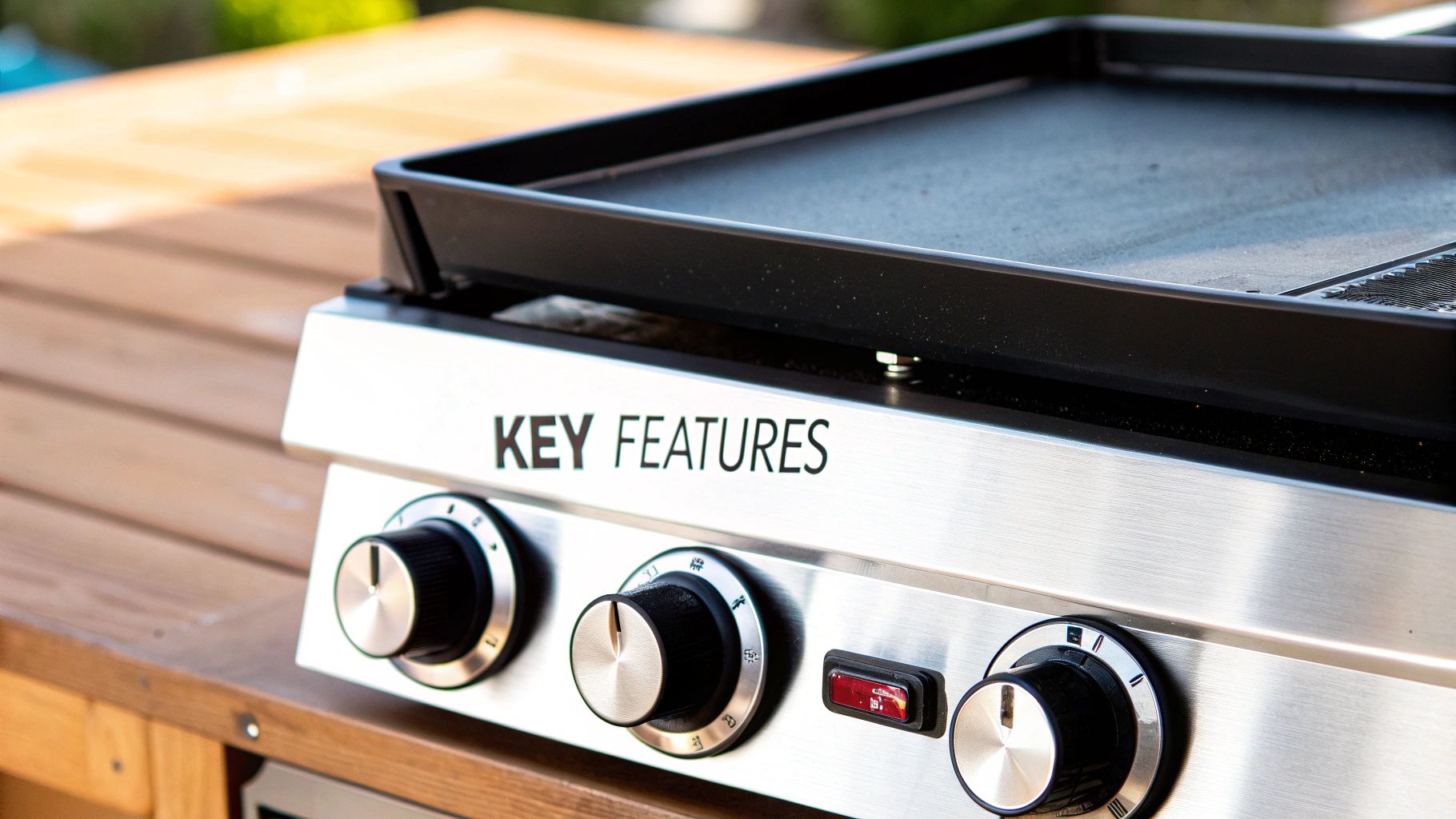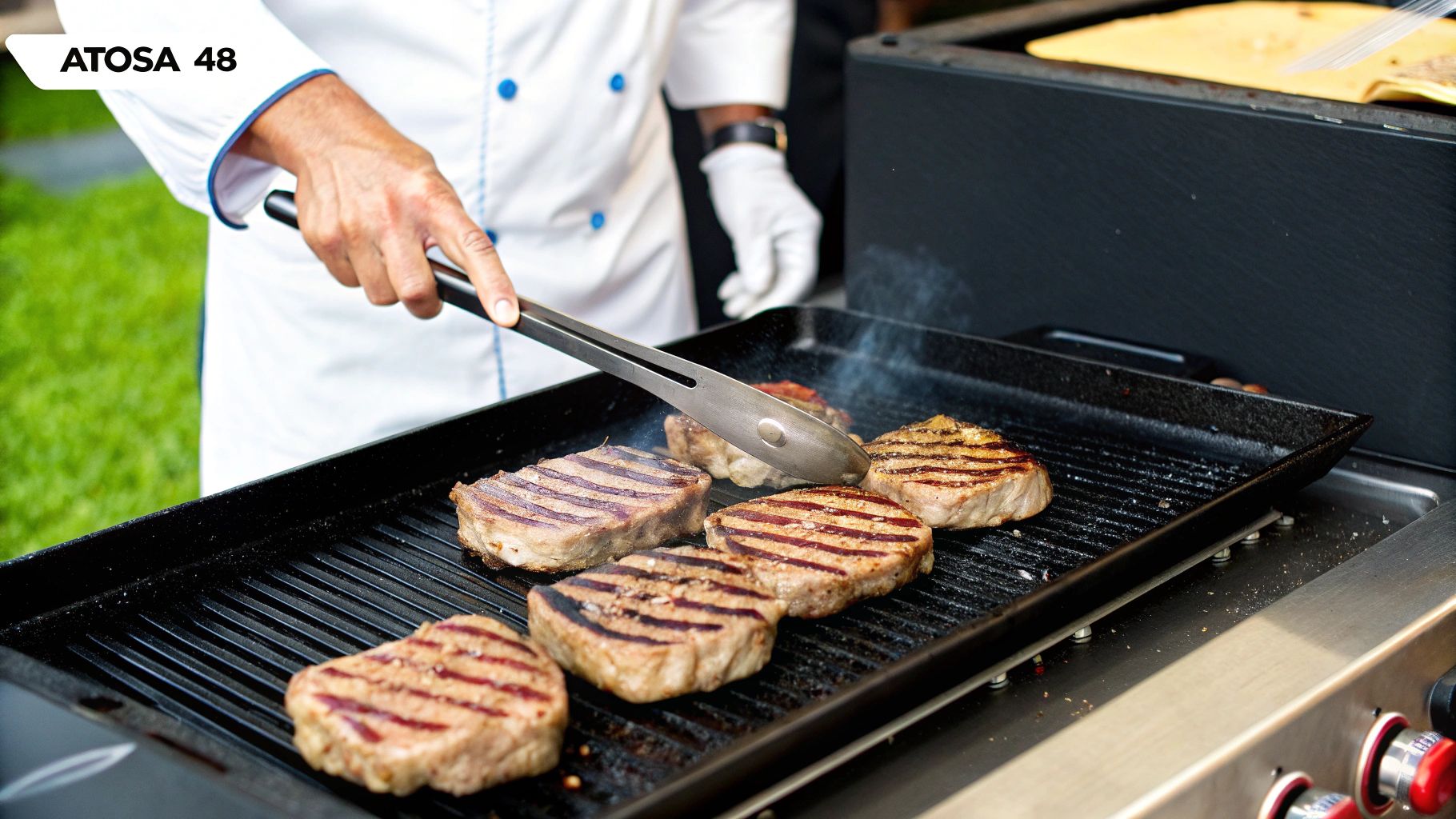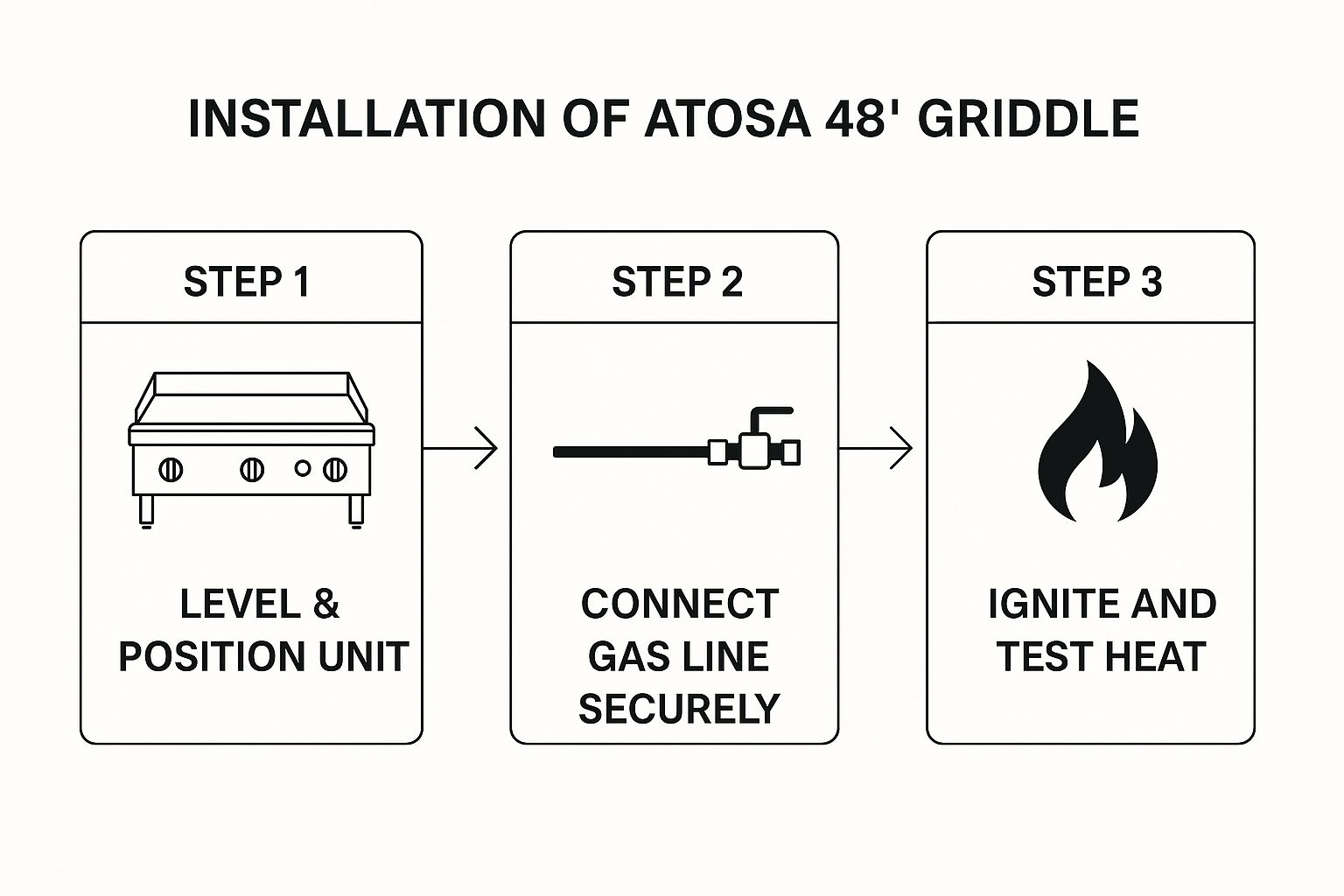
The Ultimate Atosa Griddle 48 Commercial Guide
When you're running a high-volume commercial kitchen, you need equipment that can keep up. The Atosa Griddle 48 isn't just a cooking surface; it's a heavy-duty workhorse designed for the relentless pace of busy restaurants, diners, and food trucks. It brings together a huge cooking area with burners you can control separately, making it a go-to for maximizing output and keeping your food consistent.
Why the Atosa Griddle 48 Is a Kitchen Powerhouse

In a professional kitchen, your gear is the engine that drives every single service. The Atosa Griddle 48 is built to be that engine—a true cornerstone for any operation that's serious about volume. It’s much more than just a hot plate; it's the central hub for making your line run smoothly.
It's best to think of this griddle as a smart investment in your kitchen's ability to serve quality food, plate after plate. The entire design is a direct answer to the pressures of a busy line, where there's simply no room for error when it comes to speed, consistency, and reliability.
Power and Precision Combined
What really makes this commercial griddle stand out is its blend of raw power and fine-tuned control. Models like the ATTG-48 push out a massive 120,000 BTUs of total power. This heat comes from four burners that you can control independently, which lets your chefs set up different temperature zones across the cooktop. You can find more of the nitty-gritty performance specifications on Boelter.com.
This setup is a game-changer for workflow and menu options. For example, during a dinner rush, your chef could be doing all of this at once:
- Searing off steaks and burgers on high heat in one section.
- Gently toasting buns or warming tortillas on another.
- Keeping cooked veggies ready to plate at a low, consistent temp in a third zone.
Built for the Grind
Beyond just putting out serious heat, the Atosa Griddle 48 is physically built to take a beating day in and day out in a commercial setting.
The star of the show is its heavy-duty, ¾-inch to 1-inch thick polished steel plate. That thickness isn't just for show—it holds heat incredibly well, acting as a thermal buffer to get rid of the hot spots that lead to unevenly cooked food.
This means every pancake, every burger, and every scoop of hashbrowns gets the exact same consistent heat, no matter where you drop it on the surface. That kind of reliability lets your team power through the busiest shifts with confidence, leading to faster ticket times and happier customers.
Understanding the Core Griddle Specifications

Let's be honest, staring at a spec sheet can feel like trying to read a foreign language. To really get what makes the Atosa Griddle 48 tick, we need to translate those numbers into real-world advantages that you'll feel during a chaotic service.
These specs aren't just details; they're the blueprint for this griddle's performance under pressure. Every feature is there for a reason, designed to solve the common headaches of high-volume commercial cooking, from inconsistent heat to painful cleanup.
To make it easier to see how these details translate into performance, here’s a quick overview of what makes this commercial griddle a kitchen workhorse.
Atosa Griddle 48 Specifications at a Glance
| Specification | Measurement / Detail | Performance Benefit |
|---|---|---|
| Total Power Output | 120,000 BTU | Rapid preheating and instant temperature recovery for consistent searing. |
| Griddle Plate | 3/4-inch Thick Polished Steel | Eliminates hot spots by retaining and distributing heat evenly. |
| Construction | Durable Stainless Steel | Resists corrosion, withstands kitchen abuse, and simplifies cleaning. |
| Certification | ETL Sanitation Listed | Independently verified to meet public health and safety standards. |
This table gives you the highlights, but the real value is in understanding why these specs matter for your day-to-day operations.
The Power Behind the Plate
The first thing that usually jumps out at people is the massive 120,000 BTU output. Think of BTUs (British Thermal Units) as the raw horsepower of your griddle. This is why the Atosa 48 heats up so incredibly fast, saving your crew precious time when they're opening up the kitchen.
That power is also crucial for heat recovery. You know the moment—you drop a dozen cold burger patties on the flat top, and a lesser griddle just dies. The temperature plummets, and the burgers steam instead of sear. The Atosa's high BTU rating means it bounces back almost instantly, giving you a perfect crust on every single patty, not just the first couple.
This commercial-grade power is available whether you run on natural gas or propane. If you're still on the fence about which is right for your setup, check out our guide on natural gas vs. propane for commercial kitchens.
Why Plate Thickness Is Critical
The secret weapon behind the Atosa's perfectly consistent cooking is its 3/4-inch thick polished steel plate. Picture trying to cook on a thin, flimsy cookie sheet over a flame—you'd get scorching hot spots right over the fire and cold spots everywhere else. The thick steel on the Atosa 48 acts more like a giant thermal battery.
It soaks up all that heat from the burners and spreads it evenly across the entire 48-inch surface. This is what gets rid of those frustrating hot and cold zones, ensuring that pancakes on the corner cook just as fast as the ones in the dead center.
This uniform heat distribution is what gives you true edge-to-edge cooking. You can actually use every single square inch of that surface, which is a lifesaver during a slammed brunch service. No more shuffling food around to find a "good spot."
Built for the Real World of a Commercial Kitchen
Durability in a commercial kitchen isn't just a nice-to-have; it's essential. The Atosa Griddle 48 is built with a tough stainless steel construction for both its exterior and its internal frame. It’s the go-to material for a few very good reasons:
- It Fights Back: Stainless steel stands up to the daily assault of grease, acidic spills, and harsh cleaning chemicals without rusting or breaking down.
- It Can Take a Beating: Let's face it, kitchens are tough environments. This material can handle the bumps, scrapes, and high heat without complaint.
- It Cleans Up Easy: The non-porous surface makes the end-of-night wipe-down and sanitation process quick and effective.
Finally, that little ETL Sanitation certification sticker is a big deal. It's not just marketing fluff; it's an independent confirmation that the griddle meets strict public health and safety standards. It’s your assurance that the unit is built for safe operation and can be properly sanitized, which keeps the health inspector happy and gives you peace of mind.
How a 48-Inch Griddle Can Transform Your Kitchen Workflow

In a high-pressure commercial kitchen, size isn’t just about making more food. It's about smart, efficient execution. The Atosa griddle 48 hits that perfect sweet spot for busy kitchens because its generous size directly contributes to a faster, less chaotic workflow. It's less of an appliance and more of a command center for your entire hot line.
Think about the difference between a single-lane country road and a four-lane highway. With a smaller griddle, every order has to wait its turn for a hot spot. But a 48-inch surface lets multiple cooks work shoulder-to-shoulder, handling different orders at once without tripping over each other. That space is what cuts down ticket times and keeps the kitchen from descending into chaos.
Mastering Zone Cooking
Where this commercial griddle really shines is its ability to create different heat zones across the cooktop. The Atosa griddle 48 has four powerful burners, each with its own control, allowing a chef to multitask with serious precision. This is about more than just cooking different foods—it's about managing completely different cooking processes at the same time.
This zoning capability is what gives you true menu versatility and speed. During a dinner rush, a single chef can conduct a symphony of temperatures all on one surface:
- Zone 1 (Screaming Hot): Perfect for getting a hard sear on steaks or smashing down burgers for that perfect crust.
- Zone 2 (Medium Heat): Ideal for cooking pancakes and eggs all the way through without scorching them.
- Zone 3 (Low Heat): Great for gently toasting buns, melting cheese, or warming tortillas.
- Zone 4 (Holding Temp): Keeping finished items like bacon or grilled onions perfectly warm and ready for plating.
This "zone cooking" approach lets one piece of equipment do the job of several smaller ones. It’s the secret to a cook line that can adapt on the fly, switching from the breakfast rush to dinner service without skipping a beat.
This is exactly why heavy-duty griddles are a cornerstone of the commercial kitchen equipment market. The 48-inch size of the Atosa ATMG-48 is a crowd favorite because it strikes the right balance between a huge cooking area and a footprint that doesn't eat up your entire kitchen. It’s a true high-volume workhorse.
The Strategic Footprint
While you could go bigger, the 48-inch width gives you maximum cooking real estate without overwhelming a standard cook line. You get all that production space while still leaving room for other key players like your fryers and charbroiler.
For kitchens that are feeling the squeeze with a smaller unit, upgrading to a 48-inch model is the most logical next step. A 36-inch griddle is a fantastic piece of equipment, no doubt, but that extra foot of cooktop on a 48-inch model can be the difference between just surviving a rush and actually controlling it. If you want a direct comparison, check out our guide on the Atosa 36-inch griddle.
Ultimately, this size just makes your whole operation smoother by letting you consolidate tasks onto a single, incredibly versatile surface.
Your Guide to Griddle Installation and Seasoning
Getting that new Atosa griddle 48 out of the box is a great feeling. But what you do next is what really counts. Proper installation and the initial seasoning aren't just one-time chores; they're the foundation for getting amazing results, making cleanup a breeze, and ensuring this piece of commercial equipment lasts for years.
Think of the raw steel griddle plate as a blank canvas. That first seasoning session is what turns it into the slick, naturally non-stick workhorse you need. It's a classic rookie mistake to rush this part, and it almost always leads to food sticking and a whole lot of scraping later on.
Safe and Secure Installation
Before a single burger hits the grill, you have to get the installation right. This is a big deal in a busy commercial kitchen, both for safety and for making sure the griddle runs efficiently. It's more than just finding an empty spot on the line—it means making sure the unit is perfectly level, stable, and hooked up to its fuel source correctly.
For any gas model, this is a job for a pro, period. A certified gas technician needs to handle the connection to check for leaks and set the regulator for your specific gas type. This is absolutely not the place to try and save a few bucks. A bad gas connection is a serious fire hazard.
This image lays out the three essential stages for getting your Atosa griddle 48 ready for service.

As you can see, it's a simple sequence: get it level, secure the gas line properly, and then test the heat controls to make sure everything is working like it should.
The Art of Seasoning Your Griddle
Okay, now that the griddle is safely in place, it’s time to build that perfect cooking surface. Seasoning is just the simple process of baking thin layers of oil onto the steel. This creates a dark, hard patina that works better than any chemical non-stick coating.
This first seasoning is the most important one your griddle will ever get. It creates the base layer that all future cooking will build upon, protecting the steel from rust and preventing food from gluing itself to the surface.
Here’s a simple way to get that perfect initial seasoning:
- Clean the Surface: First thing's first, wash the griddle plate with some warm, soapy water. This gets rid of any oils or dust from the factory. Rinse it well and dry it completely with a clean towel.
- Apply a Thin Layer of Oil: Grab a high-smoke-point oil (canola or basic vegetable oil works great) and pour a little on the surface. Use a clean cloth or paper towels to spread a super-thin, even coat over the entire cooktop. Don't forget the sides.
- Heat and Smoke: Crank the burners up to medium-high. You’ll want to let the griddle heat up until the oil starts to smoke. That smoke is your cue—it means the oil is polymerizing and bonding with the steel.
- Cool and Repeat: Once the smoke dies down, shut off the heat and let the griddle cool down a bit. Wipe away any pools of excess oil, then do it all over again. You'll want to repeat this process 3-4 times. With each layer, the surface will get darker and slicker.
Putting in this little bit of effort upfront will pay you back every single shift. For a deeper dive, you can learn more about how to season a new griddle and keep it in top shape. Trust me, a well-seasoned griddle makes the job faster, cleaner, and a whole lot more fun for your crew.
Keeping Your Griddle in Peak Condition
You’ve made a serious investment in your kitchen’s workhorse, the Atosa griddle 48. Just like any piece of high-performance equipment, it needs a little routine care to keep it turning out perfect dishes, shift after shift. This isn’t about adding more chores to your list; it’s about a simple, smart plan to protect your investment and guarantee it runs reliably for years.
Think of it this way: a few minutes of care at the end of the day saves you from hours of scrubbing and prevents the kind of serious buildup that can ruin food quality. Keeping your griddle in top form is the key to consistency.
Daily Cleaning Rituals
The best time to clean is right after you turn it off for the day. If you let grease and food bits sit overnight, they basically bake onto the surface, making them a nightmare to remove and potentially tainting the flavor of your breakfast service.
A quick end-of-day routine is all you need:
- Scrape It Hot: While the griddle plate is still nice and warm (not blazing hot!), grab your griddle scraper. Go over the entire surface to lift off any leftover food and grease. This is when that gunk comes off easiest.
- Dump the Grease Drawer: Carefully slide out the grease drawer and empty it. Give it a good wash with hot, soapy water. A clean drawer is essential for preventing grease fires.
- Wipe and Season: A final wipe with a damp cloth on the warm surface will steam off any last stubborn spots. To finish, wipe on a very thin coat of cooking oil. This protects the steel from moisture and gets it ready for the next day.
Periodic Checks and Upkeep
Beyond the daily wipe-down, a few quick checks every now and then will keep your Atosa griddle 48 running safely and efficiently. These tasks are your first line of defense against unexpected problems that can shut you down during a rush.
Atosa has been building gear for demanding kitchens since the early 2010s, and models like the Atosa ATTG-48 were designed from the ground up for reliability. Proper maintenance is what allows that legacy of performance to continue in your kitchen. You can see Atosa's commitment to quality for yourself in their NAFEM 2023 showcase highlights.
Your best friend in preventing downtime is a quick monthly check-up. Take a look at the pilot lights. Do they fire up right away? Is the flame a steady, healthy blue? If you see a weak, yellow, or flickering flame, that's a sign of a gas flow or burner issue that needs a professional look.
Sticking with this simple plan ensures your griddle is always ready for whatever you throw at it, protecting your investment and delivering consistent results every single time you fire it up.
Frequently Asked Questions
When you're outfitting a commercial kitchen, you're bound to have questions. Getting the right answers is the key to choosing equipment that works as hard as you do. We get a lot of inquiries about the Atosa griddle 48, so we've put together the most common ones right here.
Let's dive into everything from model specifics and fuel conversions to daily maintenance, giving you the straightforward info you need.
What Is the Difference Between the ATTG-48 and ATMG-48 Models?
This is probably the number one question we hear, and the answer comes down to one simple thing: control. It's like the difference between driving a car with an automatic transmission versus a manual one.
The ATTG-48 is your automatic. It has thermostatic controls, meaning you set a precise temperature—say, 350°F—and the griddle works to hold it there. This is a game-changer for delicate foods that demand consistent, even heat, like pancakes, eggs, or crepes. It’s the "set it and forget it" choice for kitchens that value precision.
Then you have the ATMG-48, which is your manual. It features straightforward manual controls—simple high, medium, and low knobs. This gives the chef instant, direct command over the flame intensity. It's the go-to for seasoned cooks who need to make split-second heat adjustments for things like getting the perfect sear on burgers and steaks. It puts you in the driver's seat.
So which one is right for you? It really boils down to your menu. A breakfast spot needing flawless, repeatable results will love the thermostatic model. A high-volume burger joint that lives and dies by the sear will want the responsiveness of manual controls.
Can the Atosa Griddle 48 Be Converted to Propane?
Absolutely. One of the great things about the Atosa griddle 48 is its flexibility. It typically ships set up for Natural Gas (NG), but it’s designed to be converted to Liquid Propane (LP) right in the field. Atosa even includes the conversion kit you need—with the new orifices and regulator parts—right in the box.
But, and this is important, this is not a DIY job. For safety, to meet local codes, and to keep your warranty intact, the conversion must be handled by a licensed gas technician. They have the right tools and knowledge to make sure the griddle runs safely and efficiently at the correct pressure. A bad conversion is a serious risk, leading to poor heating, dangerous fumes, and other hazards.
How Often Should I Re-Season My Atosa Griddle?
This one's easier than you might think. Once you've done that initial seasoning, a full, start-from-scratch re-seasoning is something you'll rarely, if ever, have to do. The magic of a steel griddle top is that every time you cook with fat or oil, you're constantly building and maintaining its non-stick surface.
The key is to focus on a quick daily ritual instead of a big project. At the end of every shift, after you've scraped the griddle clean, just wipe a very thin layer of cooking oil across the warm surface. This simple step does two things:
- Keeps it Non-Stick: It reinforces that slick patina, so it's ready to go for the next service.
- Protects the Steel: The oil acts as a barrier against air and moisture, preventing rust from ever getting a foothold.
The only time you'd need to do a full re-seasoning is if the surface gets damaged—maybe someone got a little too aggressive with a cleaning brick or a highly acidic sauce sat for too long and stripped the seasoning off.
What Warranty Comes with the Atosa Griddle 48?
Atosa has a solid reputation for backing up their gear, and the warranty shows it. The Atosa griddle 48 typically comes with a two-year parts and labor warranty. In the world of commercial equipment, that’s a big deal.
The "labor" coverage is especially valuable. It means if something goes wrong, a certified technician comes to you for on-site repairs, which drastically cuts down your kitchen's downtime. Just keep in mind that warranty terms can change.
It's always smart to double-check the specific warranty details with your dealer when you buy. Also, remember that warranties usually require professional installation and proper maintenance to stay valid.
Ready to add the power and versatility of an Atosa griddle 48 to your commercial kitchen? At Griddles.com, we offer a full range of Atosa equipment with free shipping and fast delivery. Explore our collection and find the perfect model for your operation at https://griddles.com.
